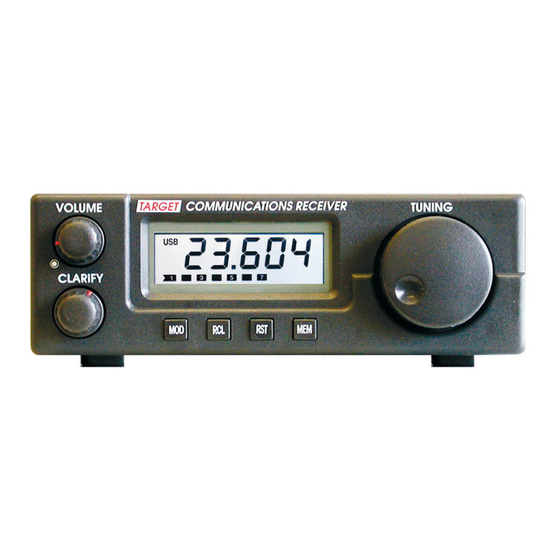
Subscribe to Our Youtube Channel
Summary of Contents for Target HF3
- Page 1 A GUIDE TO S H 0 RT W AV E L I ST E N I N G USING THE TARGET HF3 RECEIVER ALAN. J. MULLEY...
- Page 2 The TARGET HF3 receiver covers the entire spectrum from 30 kHz to MHz. For the beginner, what does this mean??? The symbol Hz (pronounced Hertz, and named after a famous radio pioneer) represents one complete electromagnetic wave in a second. A kilohertz (kHz) is one thousand waves per second, and a Megahertz (MHz), a million waves in a second.
- Page 3 All frequencies between 1.6 MHz and 30 MHz are referred to as Short Waves (S W). The HF3 covers all of these bands in one continuous sweep with steps of 1 kHz. Numbers to the left of the decimal point are in MHt whilst those to the right are in kHz.
-
Page 4: Getting Started
GETTING STARTED The HF3 is supplied with a simple long wire antenna connected to a phono plug. The wire length is feet and is a good compromise for general coverage. A shorter wire will be less sensitive and, whilst a... - Page 5 To Recall a Frequency from memory Press RCL. The S meter then becomes the memory location pointer. Select the desired memory location using the tuning knob. When the desired location is selected press RCL. The desired frequency is recalled and the receiver returned to normal operation. The RST key resets the microprocessor and reverts to memory position 1.
- Page 6 Many overseas broadcast stations welcome contact with listeners. This helps them to establish their listener profite and assess their coverage. The station will usually repay the listener with give-away goodies and a QSL card (from the international Q code meaning “acknowledge receipt”).
- Page 7 If a very strong station is encountered which causes overload and distortion then switch the attenuator to the ATTEN position. Remember to switch it back to normal for weaker stations. The HF3 has been designed to handle comparatively large signals at the antenna. A powerful local transmitter could still cause severe overload.
- Page 8 What can I receive ??? There are thousands of stations available on short wave when the conditions are right. Many will beam English programs into North America at certain times of the day. On an evening in August, English broadcasts were received from the following stations. All frequencies in kHz Voice of Vietnam 15009 &...
- Page 9 Radio Amateurs, from all over the world, were heard on the following bands:- Metre Band to 2000 (LSB) 1800 Metre Band (LSB) 3500 3800 Metre Band (LSB) 7000 7100 20 Metre Band (USB) 1400 1435 Dozens of other stations were received but not identified as their language was unfamiliar.
- Page 10 ANTENNA the end of the antenna wire to a piece of string which in turn tied to a tall object. IDEAL ANTENNA POSITION If the antenna is to be some distance from the receiver, then use 70 ohm co-ax (TV Aerial cable) between the receiver and the antenna. If an outside antenna is not practical, then the antenna can be fitted as high as possible in the loft.
-
Page 11: Troubleshooting
Troubleshooting UNIT WON’T TURN ON Check the power unit is plugged into the mains. Check the Power lead (DC) is plugged into the receiver and the receiver is switched on. If the unit is connected to an alternative power supply, check the voltage, polarity and fuse. - Page 12 RST. This performs a reset then returns to stored frequency display. NB. The HF3 receiver is optimised for speech communications. When listening to music, the audio response will be restricted. The HF3 receiver has no facility for external audio output.
- Page 13 FUNCTIONS On/Off & Volume Control Clockwise on. Continue for volume increase. Clarify Control Set at centre (blue mark up) tune either side of centre. Mode Display USB AM LSB Displays selected Mode only. Signal Strength Meter Bar Graph increases with received Signal Strength.
- Page 14 RECEIVING WEATHER FAX USING THE TARGET HF3/M MINIMUM REQUIREMENT OF PC 386 processor or better, minimum of 640k of RAM, 1.5MB free on hard disk, VGA monitor and spare COM port. (Must be COM 1 or 2) INSTALLING WE-FAX SOFTWARE ONTO HARD DISK Ensure the computer is in Dos (not in a windows environment) and the C\: prompt displayed.
- Page 15 Each station has several frequencies, select the one which gives the best results. It will vary according to the time of day. Note: Not always the strongest station gives the best results. A weaker station may have less background noise and give a clearer picture. Make sure you are satisfied with the quality of signal you’re receiving on the computer.
- Page 16 Pressing the S key will alternately start and stop the picture. Wait for a picture and start printing. Adjust the clarify control for best contrast, only a small movement is necessary. Turning clockwise will increase the pitch of the note from the receiver and make the picture lighter. Adjust until the background is peak white and the dark areas are black.
- Page 17 Select C to set up the serial port and also select the Baud rate of the transmission. Command E is included to allow the invocation of an external text editor to view and manipulate received text. As a default it is assumed that a copy of the DOS editor (EDIT.COM) resides in the WEATHER directory.



Need help?
Do you have a question about the HF3 and is the answer not in the manual?
Questions and answers